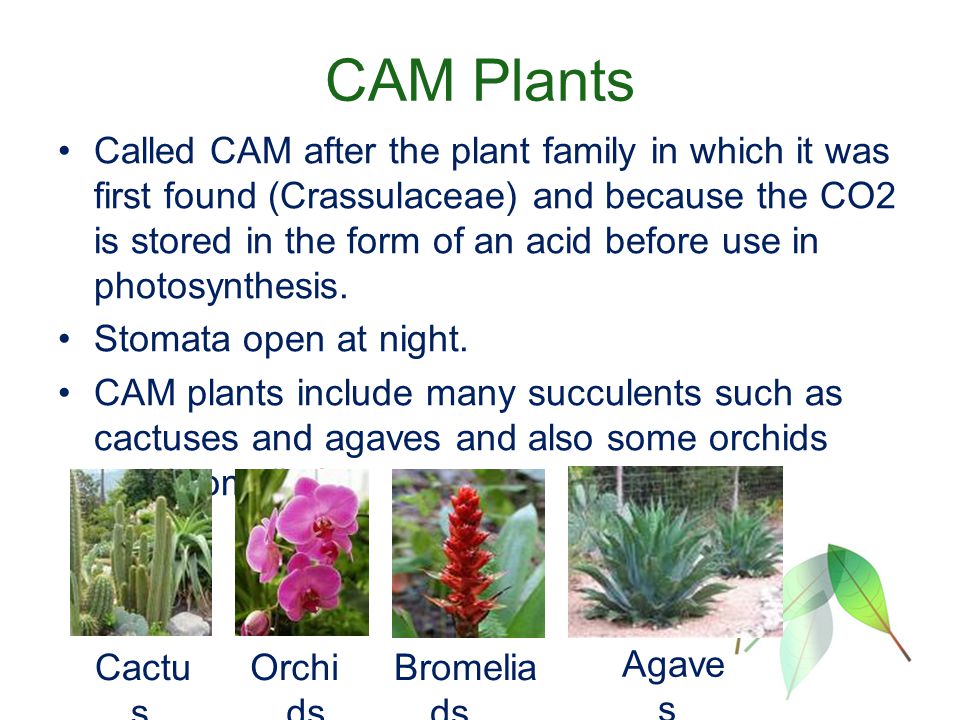Cam Plants Examples
CAM Crassulacean Acid Metabolism is a pathway of photosynthesis which occurs in desert succulents. CAM plants exhibit the highest water-use efficiencies in plants which enable them to do well in water-limited environments such as semi-arid deserts.

Pin On Garden Source: www.pinterest.com
C3 can be seen in all photosynthetic plants while C4 is followed by tropical plants and CAM by Semi-arid condition plants.

Cam plants examples. With the exceptions of pineapple and a few agave species such as the tequila agave CAM plants are relatively unexploited in terms of human use for food and energy resources. Examples of CAM plants. At night stomata are open by PEPA and OAA in the presence of PEPAcarboxylase.
3 rows Some plants that are adapted to dry environments such as cacti and pineapples use the. Their stomata opens at night. C3 can be seen in all photosynthetic plants while C4 is followed by.
Many cacti and agaves seem to operate at or close to the full-CAM end of the phenotypic C 3 CAM spectrum Nobel 1988 and are traditionally and rightly considered CAM plants. A C4 plant is a plant that cycles carbon dioxide into four-carbon sugar. Examples are Indiana grass big bluestem Bermudagrass CAM Plants In this type of photosynthesis entities absorb energy during daytime from sunlight using this energy at the night aby gathering carbon dioxide.
In this pathway of photosynthesis carbon is fixed during night time while decarboxylation reaction takes place at day time. Kalanchoe pinnata would also qualify for the CAM plant category. An example of C3 are Sunflower Spinach Beans Rice Cotton while the example of C4 plants is Sugarcane Sorghum and Maize and Cacti orchids are the example of CAM plants.
Some examples of CAM plants are as follows. Some of the common examples of CAM plants Orchids Cacti Aloe Pineapple Agave Moringa Some species of Euphorbia and Bromelioideae etc. By keeping the stomata closed during the day the plant minimizes water loss.
In C3 plants the carbon dioxide fixation takes place only at one place Examples of C3 plants include sunflower beans wheat oats rice cotton chlorella spinach rice cotton etc What are C4 Plants. However non-desert plants like pineapples and epiphyte plants such as orchids also use CAM photosynthesis. This 5 video explains Crassulacean acid metabolism CAM pathway020 CAM pathway simplified305 Why C3 C4 and CAM cycle408 Examples of CAM plantsWatch C3.
CAM photosynthesis allows plants to survive in arid climates and therefore is the type of photosynthesis used by cacti and other desert plants. Crassulacean acid metabolism also known. Due to excessive heat the stomata remains closed during the day to reduce transpiration.
The key difference between C4 and CAM plants is that in C4 plants carbon fixation takes place in both mesophyll and bundle sheath cells while in CAM plants carbon fixation takes place only in mesophyll cells. CAM plants are succulents and grow in dry regions. Most of the plants follow the Calvin cycle which is the C3 photosynthesis pathwayThese plants grow in regions where there is adequate water availability.
Many succulent plants like the popular jade and aloe houseplants. Despite significant C 3 -type CO 2 exchange during early development CAM eventually becomes the major contributor to leaf life cycle carbon gain. 44 rows The pineapple is an example of a CAM plant.
This was a brief note on CAM Plants. An example of C3 are Sunflower Spinach Beans Rice Cotton while the example of C4 plants is Sugarcane Sorghum and Maize and Cacti orchids are the example of CAM plants.

C3 C4 And Cam Plants Biology Diagrams Biology Notes Organic Molecules Source: www.pinterest.com

Pin On Scouts Source: www.pinterest.com

Photosynthesis C3 C4 Cam Plants Ppt Video Online Download Source: slideplayer.com

Cam Plants Cam Pathway And Its Advantages With Examples Youtube Source: www.youtube.com

What Are Some Examples Of A Cam Plant Quora Source: www.quora.com

Pin On Plants Source: www.pinterest.com
